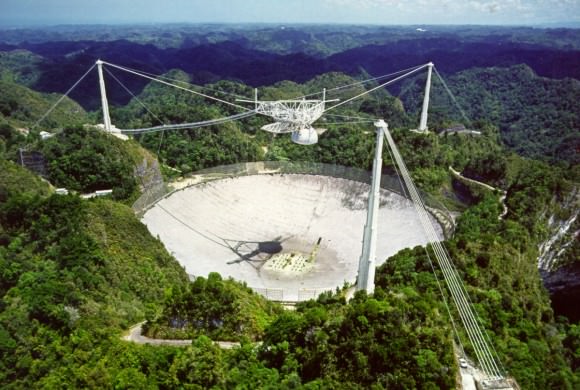Since they were first detected in 2007, Fast Radio Bursts (FRBs) have been a source of mystery to astronomers. In radio astronomy, this phenomenon refers to transient radio pulses coming from distant sources that typically last a few milliseconds on average. Despite the detection of dozens of events since 2007, scientists are still not sure what causes them – though theories range from exploding stars, black holes, and magnetars to alien civilizations!
To shed light on this mysterious phenomena, astronomers are looking to new instruments to help search for and study FRBs. One of these is the Canadian Hydrogen Intensity Mapping Experiment (CHIME), a revolutionary new radio telescope located at the Dominion Radio Astrophysical Observatory (DRAO) in British Columbia. On July 25th, still in its first year, this telescope made its first-ever detection, an event known as FRB 180725A.
The detection of FRB 180725A was announced online in a “Astronomer’s Telegram” post, which is intended to alert the astronomical community about possible new finds and encourage follow-up observations. The detection of FRB 180725A is very preliminary at this point, and more research is needed before its existence as an FRB can be confirmed.
As they stated in the Astronomers Telegram announcement, the radio was signal was detected on July 25th, at precisely 17:59:43.115 UTC (09:59.43.115 PST), and at a radio frequency of 400 MHz:
“The automated pipeline triggered the recording to disk of ~20 seconds of buffered raw intensity data around the time of the FRB. The event had an approximate width of 2 ms and was found at dispersion measure 716.6 pc/cm^3 with a signal-to-noise ratio S/N ~20.6 in one beam and 19.4 in a neighboring beam. The centers of these, approximately 0.5 deg wide and circular beams, were at RA, Dec = (06:13:54.7, +67:04:00.1; J2000) and RA, Dec = (06:12:53.1, +67:03:59.1; J2000).”
Research into Fast Radio Bursts is still in its infancy, being a little more than a decade old. The first ever to be detected was the famous Lorimer Burst, which was named after it discoverer – Duncan Lorimer, from West Virginia University. This burst lasted a mere five milliseconds and appeared to be coming from a location near the Large Magellanic Cloud, billions of light years away.
So far, the only FRB that has been found to be repeating was the mysterious signal known as FRB 121102, which was detected by the Arecibo radio telescope in Puerto Rico in 2012. The nature of this FRB was first noticed by a team of students from McGill University (led by then-PhD Student Paul Scholz), who sifted through the Arecibo data and determined that the initial burst was followed by 10 additional burst consistent with the original signal.

In addition to being the first time that this Canadian facility detected a possible FRB coming from space, this is the first time that an FRB has been detected below the 700 MHz range. However, as the CHIME team indicate in their announcement, other signals of equal intensity may have occurred in the past, which were simply not recognized as FRBs at the time.
“Additional FRBs have been found since FRB 180725A and some have flux at frequencies as low as 400 MHz,” they wrote. “These events have occurred during both the day and night and their arrival times are not correlated with known on-site activities or other known sources of terrestrial RFI (Radio Frequency Identification).”
As a result, this most-recent detection (if confirmed) could help astronomers shed some additional light on what causes FRBs, not to mention place some constraints on what frequencies they can occur at. Much like the study of gravitational waves, the field of study is new but rapidly growing, and made possible by the addition of cutting-edge instruments and facilities around the world.
Further Reading: CNET


I do not dare to guess what causes an FRB, but … What would happen if one single (randomly generated) photon went through an excited gas cloud? Couldn’t it generate a paket of radio waves by stimulated emission similar to FRB?